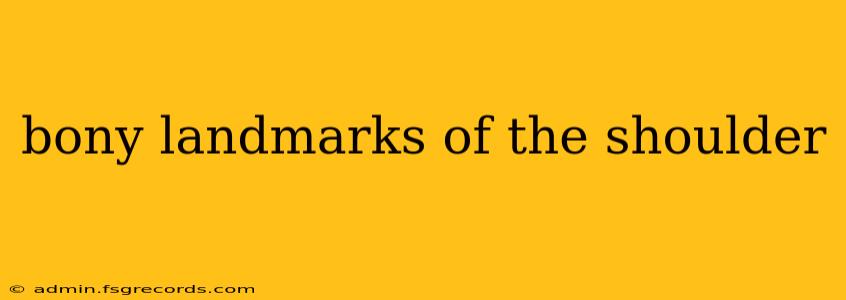The shoulder, a marvel of human biomechanics, boasts a complex interplay of bones, muscles, ligaments, and tendons. Understanding its bony landmarks is crucial for healthcare professionals, athletes, and anyone interested in anatomy and movement. This guide provides a detailed overview of the key bony structures that contribute to the shoulder's intricate functionality.
Major Bones of the Shoulder Girdle
The shoulder girdle, or pectoral girdle, comprises three bones: the clavicle (collarbone), scapula (shoulder blade), and humerus (upper arm bone). Each bone contributes distinct landmarks vital for muscle attachment, joint formation, and overall shoulder stability.
1. Clavicle (Collarbone):
The clavicle, an S-shaped bone, acts as a strut connecting the sternum (breastbone) to the scapula. Its key landmarks include:
- Sternal End: The medial end, articulating with the manubrium of the sternum at the sternoclavicular joint (SC joint). This is a palpable landmark easily felt at the base of the neck.
- Acromial End: The lateral end, articulating with the acromion process of the scapula at the acromioclavicular joint (AC joint). This is also easily palpable at the shoulder's outermost point.
- Conoid Tubercle: A small bump on the inferior surface of the acromial end, providing attachment for the conoid ligament.
- Trapezoid Ridge: A roughened area located between the conoid tubercle and the acromial end; it serves as an attachment site for the trapezoid ligament.
2. Scapula (Shoulder Blade):
The scapula, a flat triangular bone, rests on the posterior thoracic wall. Its numerous bony prominences offer extensive sites for muscle attachment and contribute to the shoulder's remarkable range of motion. Key landmarks include:
- Acromion Process: A large, flat projection forming the highest point of the shoulder. It articulates with the clavicle to form the AC joint. Easily palpable beneath the skin.
- Coracoid Process: A hook-like projection on the anterior side of the scapula, providing attachment points for several muscles and ligaments. It's located inferomedial to the acromion. While less prominent than the acromion, it's still palpable with some practice.
- Glenoid Cavity (Fossa): A shallow, pear-shaped depression on the lateral aspect of the scapula. This forms the socket for the humeral head in the glenohumeral joint.
- Spine of the Scapula: A prominent ridge running diagonally across the posterior surface of the scapula, separating the supraspinous fossa (above the spine) from the infraspinous fossa (below the spine). The spine is readily palpable.
- Superior Angle: The upper corner of the scapula, located at the junction of the superior border and medial border.
- Inferior Angle: The lower corner of the scapula, located at the junction of the medial and lateral borders.
- Medial Border (Vertebral Border): The inner edge of the scapula, parallel to the spine.
- Lateral Border (Axillary Border): The outer edge of the scapula, forming a part of the shoulder's outline.
3. Humerus (Upper Arm Bone):
The humerus, the longest bone of the upper limb, articulates with the scapula at the glenohumeral joint and with the ulna and radius at the elbow joint. Crucial landmarks include:
- Head of the Humerus: The rounded proximal end of the humerus, fitting into the glenoid cavity.
- Greater Tubercle: A large prominence located laterally on the proximal humerus, providing attachment sites for several rotator cuff muscles.
- Lesser Tubercle: A smaller prominence located medially to the greater tubercle, also serving as a rotator cuff muscle attachment site.
- Intertubercular Sulcus (Bicipital Groove): The groove between the greater and lesser tubercles, housing the long head of the biceps brachii tendon.
- Surgical Neck: A constricted area just distal to the tubercles, a common site for humeral fractures.
- Deltoid Tuberosity: A raised area on the lateral aspect of the humeral shaft, providing attachment for the deltoid muscle.
- Epicondyles (Medial and Lateral): Prominent bony processes located distally on the humerus. They serve as attachments for forearm muscles.
Clinical Significance of Shoulder Bony Landmarks
Accurate identification of these bony landmarks is critical in:
- Physical Examination: Palpation of these landmarks assists in evaluating shoulder injuries, assessing muscle tone and atrophy, and identifying joint instability.
- Imaging Interpretation: Radiographic images (X-rays, CT scans, MRI) require a solid understanding of bony anatomy for accurate interpretation.
- Surgical Procedures: Precise localization of bony landmarks is crucial for successful shoulder surgeries.
- Injections: Identifying specific landmarks guides accurate injections into the shoulder joint.
This comprehensive overview provides a solid foundation for understanding the bony landmarks of the shoulder. Further study of muscle attachments and joint mechanics will provide a more complete appreciation of this complex and dynamic region. Remember, this information is for educational purposes and should not be substituted for professional medical advice.

